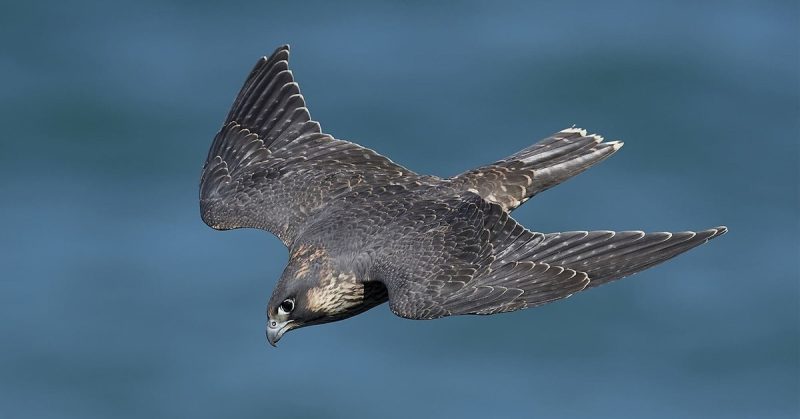The Speed King of the Animal World
High above, a dark shape hovers—then folds its wings and plunges. In seconds, it slices through the sky at record-breaking speed. This is the peregrine falcon, nature’s fastest predator.
Reaching up to 240 mph (386 km/h) in a dive, the peregrine isn’t just fast—it’s a precision hunter shaped by millions of years of evolution. From its streamlined body to laser-sharp vision, every feature is built for the perfect aerial attack.
What makes this crow-sized raptor so extraordinary? This article dives into the science behind the peregrine’s power, exploring the physics, biology, and high-speed genius of the world’s fastest animal.

Meet the Peregrine Falcon
The peregrine falcon (Falco peregrinus) is a true global traveler, found on every continent except Antarctica. Whether perched on coastal cliffs, soaring over deserts, gliding across grasslands, or even navigating the steel canyons of urban high-rises, this raptor’s ability to adapt to virtually any environment showcases its unrivaled hunting prowess.
With a wingspan of 3.3 to 3.6 feet (1 to 1.1 meters) and weighing between 1 to 3.5 pounds (0.4 to 1.6 kilograms), peregrines are medium-sized but extremely powerful. Their striking bluish-gray plumage above contrasts with their lighter, barred underside, while their black “moustache” mark beneath the eyes gives them a fierce, unmistakable appearance.
Once on the brink of extinction due to the widespread use of pesticides, peregrines have made an incredible recovery. From near extinction to conservation triumph, these birds are not just symbols of strength, but also of the resilience of nature. Historically prized by falconers for their unmatched speed and trainability, peregrines now stand as icons of both natural power and the success of modern conservation efforts.
Record-Breaking Speed: Fact vs. Fiction
In full stoop, peregrine falcons have been clocked at speeds exceeding 240 mph (386 km/h). These measurements are not speculative—they come from rigorous studies using radar tracking, high-speed photography, and GPS telemetry. Scientists have repeatedly confirmed these top speeds, both in wild falcons and in controlled experimental setups.
To truly appreciate this velocity, consider other fast animals: cheetahs—the fastest land mammals—can sprint up to 60 mph (97 km/h), while a human skydiver in free fall may reach around 120 mph (193 km/h) before deploying a parachute. Peregrines more than double those numbers, making them not just fast, but in a league of their own.
It’s important to note that this speed is achieved during a specific hunting maneuver: the stoop. This controlled dive begins with a steep angle of descent and uses gravity, streamlined body posture, and wing positioning to reach terminal velocity. Unlike cruising or flapping speeds, the stoop is an extraordinary burst used with purpose and precision.
What makes the peregrine’s achievement even more astonishing is how it manages this speed while remaining in complete control. Rather than tumbling or losing sight of its prey, the falcon adjusts its wings and tail with micro-movements to stay on course and time its strike to perfection.
This is not just the fastest animal in terms of raw speed—it’s also one of the most efficient, stable, and lethal fliers the natural world has ever produced.
Anatomy of Speed: Evolutionary Engineering
Aerodynamic Body Design
The peregrine falcon’s body is a masterpiece of natural engineering, built for speed and precision. In a high-speed dive, its form transforms into a sleek teardrop shape, perfectly streamlined to slice through the air with minimal drag. It tucks its wings tightly against its body, becoming a compact missile hurtling toward its target. Each feather is precisely contoured to manage airflow, reducing turbulence and helping the falcon stay stable and in control—even at speeds over 200 miles per hour. This aerodynamic design is what allows the falcon to strike with both power and pinpoint accuracy.
Skeletal and Muscular Adaptations
The peregrine falcon’s skeleton is a blend of strength and lightness, perfectly suited for high-speed flight. Its bones are lightweight to aid in soaring, yet fused in key areas to provide rigidity and stability during rapid maneuvers. A pronounced keel on the breastbone serves as the anchor for massive pectoral muscles, enabling the powerful wingbeats that drive its flight. Remarkably, its neck vertebrae are specially adapted to absorb the intense shock of high-speed impacts, protecting the falcon’s brain and spine when it strikes prey mid-air at over 200 miles per hour.
Specialized Respiratory System
To survive the extreme conditions of high-speed dives, peregrine falcons have a uniquely adapted respiratory system. Inside their nostrils are small bony structures called tubercles that act like pressure regulators, disrupting fast-moving air and preventing their lungs from being overwhelmed during a stoop. This allows them to breathe safely even at speeds exceeding 200 miles per hour. Additionally, their respiratory system includes a network of air sacs that ensures a continuous flow of oxygen through the lungs—providing the stamina needed for powerful flight and intense aerial pursuits.
Visual Precision: The Falcon’s Secret Weapon
Superhuman Visual Acuity
The peregrine falcon’s eyesight is nothing short of extraordinary, with a visual acuity that surpasses human limits—rated at 20/5 or even 20/2. This means they can see details at 20 feet that a human can only spot from just 5 feet away. Such remarkable vision allows them to spot tiny prey, like pigeons, from distances of up to 3 kilometers. This superhuman ability not only aids in hunting but also helps them calculate the perfect moment to dive, ensuring a successful strike from the sky.
Dual Foveae
Peregrine falcons have a unique advantage in their eyes: each one contains two foveae, or focal centers. One fovea focuses directly ahead, allowing them to lock in on a target with laser precision, while the other scans the periphery, giving them a broad field of view. This dual-vision system enables falcons to track fast-moving prey without losing awareness of their surroundings—perfect for hunting at high speeds, where split-second decisions can mean the difference between success and failure.
Ultraviolet Sensitivity and Glare Reduction
Peregrine falcons also have the ability to see in the near-ultraviolet spectrum, a key advantage that allows them to detect subtle cues like scent trails or droppings left by prey—details completely invisible to humans. Their eyes are further equipped with a special layer of oil that acts as a natural filter, reducing glare from the sun and enhancing contrast. This is especially crucial when chasing prey against bright, open skies, allowing them to maintain sharp focus and precision even in the most challenging conditions.
The Mechanics of the Dive
The Stoop
The peregrine’s stoop begins with a powerful ascent, gaining altitude before the bird angles downward toward its target. As it folds its wings tightly against its body, gravity takes over, accelerating the falcon toward earth at astonishing speeds. Despite the intense forces at play, the falcon maintains perfect control, making subtle, rapid adjustments with its tail and wingtips to fine-tune direction and speed. This combination of gravity, posture, and precise movements allows the falcon to execute its high-speed dive with unmatched accuracy and efficiency.
Impact Strategy
When a peregrine falcon strikes, it often does so with closed talons, delivering a concussive blow that stuns or kills its prey on impact. This mid-air strike is so powerful that the falcon may incapacitate its target without needing to physically grasp it right away. If the prey falls, the falcon circles back to recover it. Its talons, sharp and curved, are perfectly designed for gripping and holding onto prey, even in the fast-moving chaos of an aerial hunt.
Navigating the Air
During a high-speed stoop, peregrine falcons face intense air pressure and rapidly shifting visual input, demanding lightning-fast responses from their brains and muscles. To stay focused and maintain control, specialized neck muscles work to keep their heads level and eyes locked on the target, despite the chaos of turbulent air. This precise coordination allows the falcon to navigate through the dive with remarkable stability, ensuring both accuracy and safety during such a high-stakes aerial pursuit.
Falcon Chicks and Learning to Fly
Falcons nest on cliff ledges or tall man-made structures. Females typically lay 2 to 5 eggs, incubated by both parents. The nest, or scrape, is usually a shallow depression lined with debris.
Chicks, known as eyasses, hatch with fluffy white down and grow rapidly. Around 6 weeks, they fledge—taking their first flight. Early flights are short and clumsy, but with parental encouragement and practice, young falcons learn to dive and hunt. Juveniles spend weeks perfecting their skills through play-fighting and mock hunts.
Urban Life: Thriving in Cities
Cities offer the peregrine falcon high perches and abundant food, particularly pigeons and starlings. Tall buildings mimic cliffs, making skyscrapers ideal nesting sites. Urban falcons have been recorded performing stoops between towers and catching prey mid-flight above crowded streets.
Many cities now support peregrine populations with artificial nest boxes. Urban environments also expose the falcons to fewer predators, and building ledges offer safety and a clear view of hunting grounds. Birdwatchers in cities often follow nesting pairs, sometimes through live-streamed nest cams.
Tech Inspired by Peregrines
Falcon-inspired technology is shaping fields from robotics to aviation. Engineers analyze how falcons stabilize their vision to improve motion-tracking in drones. The teardrop dive posture has influenced aircraft and projectile design. Robotics companies study wing folding mechanisms for improved aerodynamics in high-speed vehicles.
Artificial vision systems in autonomous aircraft now use algorithms modeled on the way falcons track moving objects while filtering out background motion. Even sports helmet manufacturers have adapted falcon-like airflow dynamics for safety and efficiency.
Conservation and Recovery
The peregrine falcon was nearly wiped out in the mid-20th century due to DDT, a pesticide that caused eggshells to thin and break. In some areas, populations dropped by 90%. Recovery began with a worldwide ban on DDT and breeding programs led by scientists and conservation groups.
Captive-bred birds were released into the wild across North America and Europe. With legal protections and public education, peregrine numbers have bounced back. They are now common in many major cities and are considered a conservation success story.
Monitoring programs continue to track falcon populations, and habitat protection remains a priority. The peregrine’s recovery is not just a win for the species—it’s a symbol of what humans can do when science and action come together.
Conclusion: Nature’s Perfect Predator
The peregrine falcon isn’t just fast—it’s the epitome of biological refinement. With unmatched speed, pinpoint vision, aerodynamic design, and strategic intelligence, it reigns as the fastest animal on Earth.
Each dive is a display of evolutionary engineering: precise, powerful, and breathtaking. Whether slicing through the skies above wilderness cliffs or between skyscrapers, the peregrine falcon is proof that nature can achieve perfection through adaptation and survival.






